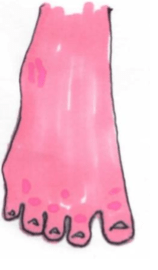In class we do a lot to work our feet. Simple warm up exercises such as rising up and down on the tip toes and using the spiky ball are quite regular. But why?
Well first up our feet play an important role in how the rest of the body works. After all we stand and walk on our feet. They form the base of stability for the rest of the joints going up the body. For instance if you have collapsed arches or roll out to the side of the foot, this will cause a knock-on effect to the knees and hips. This can lead to back pain and even compensation patterns within the neck and shoulders. Hammer toes and bunions can also cause our walking and standing gait to change. If we can’t spread our weight evenly on toes and feet then the body again has to adjust to this. Over time this can lead to muscle imbalances, causing pain and discomfort.
Secondly the feet have a connection to the pelvic floor and deep abdominal muscles. When the feet work and move properly we are better able to connect to these other muscles.
Finally when we challenge our body with balance we also work our deep stabilising muscles. This can also be a great way to train them during early pregnancy and help to prevent the feet from flattening later on.
So what can we do help ensure our feet are working optimally? The spiky balls help to relieve any tension, which is great for conditions like plantar faciitis. They also help them to ‘wake up’, stimulating the muscles and nervous system. Simple exercise such as trying to spread your toes and lift each toe individually are really good at getting the muscles to work more effectively. Interestingly, the feet should mimic most of the movements in your hands (Katy Bowman)! Just like any other muscle in the body, giving the feet and calves a good old stretch will help them to move, feel and function better. Put your fingers between your toes and gently spread them apart.
Finally think about the shoes you wear – pointy toes, high heels, flip flops? These can all lead to the toes being squashed or gripping for support. The toes should have space to spread with good support and very little heel lift. However, wearing ‘bad’ shoes occasionally is always acceptable!
For more information on how to work your feet, improve arch strength and bunion rehab, look out for the foot workshop and mini course coming soon!


